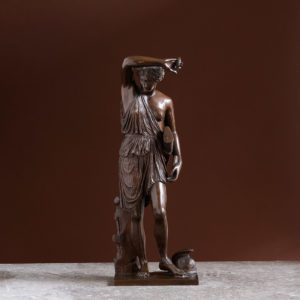No products in the basket.
69 items found
Page 1 of 1
-

Mid-nineteenth century Italian bronze sculptures of Creugas and Damoxenes
£15,000Mid-nineteenth century Italian bronze sculptures of Creugas and Damoxenes
set atop serpentine columns. Creugante: Height 70.5 cm Width 42 cm Depth 18.5 cm Damosseno: Height 60 cm Width 39 cm Depth 18 cm Plinth: Height 119 cm Width: 44 cm Depth: 23.5 cm£15,000 -

Mid-nineteenth century French bronze figure of the Borghese Gladiator,
£6,500Mid-nineteenth century French bronze figure of the Borghese Gladiator,
cast by Ferdinand Barbedienne, after the antique.£6,500 -

Large bronze model of a seated Mercury,
£4,850Large bronze model of a seated Mercury,
late nineteenth century or early twentieth century, French,base diameter 27 cm.£4,850 -

Bronze figure of the dying Gaul
£4,500 -

Nineteenth century Italian bronze model of Seated Hermes
£3,800Nineteenth century Italian bronze model of Seated Hermes
stamped 'GIORGIO SOMMER FOUNDRY, NAPLES', set on marble plinth base.£3,800 -

Exceptional pair of foundry crucibles,
£2,850Exceptional pair of foundry crucibles,
well patinated throughout, previously drilled for used as planters.£2,850 -
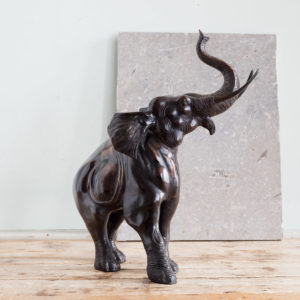
Japanese bronze of an elephant
£2,500 -

Pair of plaster statues of Hebe and Diana of Gabii,
£2,500 the pair -

Nineteenth century Devonian limestone column,
£2,200Nineteenth century Devonian limestone column,
the fluted shaft on plinth base. Likely a variety of Petitor.£2,200 -

Nineteenth century gilt bronze model of Sappho,
£2,200Nineteenth century gilt bronze model of Sappho,
set atop Verde Antico marble base, with ball feet.£2,200 -
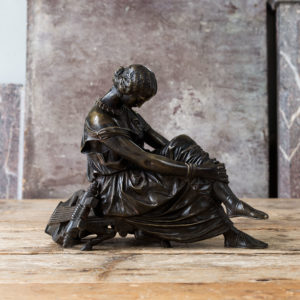
Nineteenth century French bronze of Sappho
£1,950 -

French Bronze of Euterpe
£1,850 -

Lead statue of the Neopolitan Fisherboy
£1,850 -

Bronze model of Diana the Huntress
£1,500Bronze model of Diana the Huntress
French c.1900, after the original by Jean-Antoine Houdon (1741-1828)£1,500 -

Pair of nineteenth century bronze figures of Harvest and Plenty,
£1,250 -

Large Italian figure of Venus after the Bath
£1,250Large Italian figure of Venus after the Bath
recently made in reconstituted marble, with surface wear and minor marks, suitable for exterior use.£1,250 -

Italian bronze bust of Demosthenes
£1,250Italian bronze bust of Demosthenes
mid-nineteenth century Italian, the great Greek orator modelled wearing a tunic, on marble plinth base£1,250 -

Nineteenth century copper repoussé charger,
£1,250 -
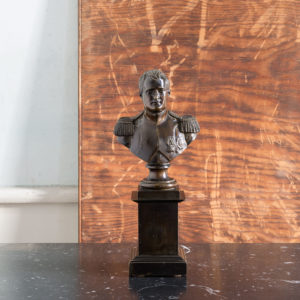
Nineteenth century bronze of Napoleon Bonaparte,
£1,000 -

Acanthine carved gilt pelmet
£950 -

Pair of twentieth century gilt brackets
£850 -
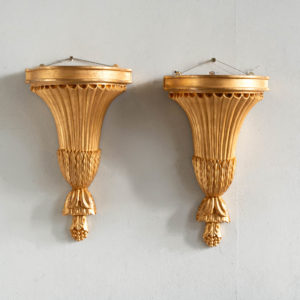
Pair of twentieth century gilt wall brackets
£850 -

Pair of twentieth century giltwood cornucopia
£600 -

Small pair of foundry crucibles,
£500 -

Congolese Songye door
£480 -

Brass model of a rearing horse,
£400 -

Luba female / male stool,
£375Luba female / male stool,
Luba art relates most commonly to the Kings and Chiefs of the Congolese Luba tribe, who would assert their power by display of ceremonial objects during ceremonies. Stools were considered to be the most important of these objects as they would serve not only as a seat but as a receptacle for the Chief’s spirit. The ruler is thus figuratively and literally supported by a caryatid figure - in this case both male and female standing figures. The male is seen with inset cowrie shell eyes, believed by many African tribes to contain divine powers.£375 -

Luba stool
£375Luba stool
Luba art relates most commonly to the Kings and Chiefs of the Congolese Luba tribe, who would assert their power by display of ceremonial objects during ceremonies. Stools were considered to be the most important of these objects as they would serve not only as a seat but as a receptacle for the Chief’s spirit. The ruler is thus figuratively and literally supported by a caryatid figure - in this case a standing female ancestor. The carvings seen on her stomach allude to the maternal - such markings were common among many matrilineal societies in Africa to emphasise and protect the navel as the threshold between oneself, one’s mother and one’s own lineage.£375 -

Cast terracotta lion’s mask plinth
£350 -

Pair of cast iron Canova lions
£350 the pairPair of cast iron Canova lions
the original sculpted by Antonio Canova in 1792 for the tomb of Pope Clement XIII in St. Peter's, Rome.£350 the pair -

Songye Kilumwe Kifwebe mask (A)
£350Songye Kilumwe Kifwebe mask (A)
Very large Kifwebe mask with exaggerated sagittal crest. It is believed that the sagittal crest and conical protrusion contain the magical strength of the mask.£350 -

Luba stool,
£350Luba stool,
Luba art relates most commonly to the Kings and Chiefs of the Congolese Luba tribe, who would assert their power by display of ceremonial objects during ceremonies. Stools were considered to be the most important of these objects as they would serve not only as a seat but as a receptacle for the Chief’s spirit. The ruler is thus figuratively and literally supported by a caryatid figure - in this case a kneeling female ancestor with elongated and outstretched fingertips. The deep carvings seen on her stomach allude to the maternal - such markings were common among many matrilineal societies in Africa to emphasise and protect the navel as the threshold between oneself, one’s mother and one’s own lineage.£350 -

Tabwa stool
£350Tabwa stool
Congolese Tabwa art has distinct similarities to that of the Luba tribe, and its stools are used also in ceremonies by the Kings and Chiefs of the community with a means of establishing power and authority. The key difference seen between the two is the Tabwa’s traditional depiction of braided hair as a carved extension of the head and checkerboard-style scarification of the woman’s body.£350 -

Songye Janus standing power figure,
£325Songye Janus standing power figure,
Congolese double-faced maternal power figure, adorned with animal hide and cowrie shells. The Songye power figure serves to protect its community from evil spirits.£325 -

Songye standing male power figure,
£325Songye standing male power figure,
Standing male power figure from the Congolese Songye tribe, beautifully adorned with natural fibres, animal hide, and miniature power figure. These wooden power figures would have served to protect the Songye community from evil spirits and practitioners.£325 -

Luba stool
£325Luba stool
Luba art relates most commonly to the Kings and Chiefs of the Congolese Luba tribe, who would assert their power by display of ceremonial objects during ceremonies. Stools were considered to be the most important of these objects as they would serve not only as a seat but as a receptacle for the Chief’s spirit. The ruler is thus figuratively and literally supported by a caryatid figure - in this case a posed female ancestor with a carved headdress and jewellery.£325 -

Luba stool
£325Luba stool
Luba art relates most commonly to the Kings and Chiefs of the Congolese Luba tribe, who would assert their power by display of ceremonial objects during ceremonies. Stools were considered to be the most important of these objects as they would serve not only as a seat but as a receptacle for the Chief’s spirit. The ruler is thus figuratively and literally supported by a caryatid figure - in this case a kneeling female ancestor adorned with beaded and carved jewellery. The deep carvings seen on her stomach allude to the maternal - such markings were common among many matrilineal societies in Africa to emphasise and protect the navel as the threshold between oneself, one’s mother and one’s own lineage. Damage to left hand.£325 -

Luba stool,
£300Luba stool,
Luba art relates most commonly to the Kings and Chiefs of the Congolese Luba tribe, who would assert their power by display of ceremonial objects during ceremonies. Stools were considered to be the most important of these objects as they would serve not only as a seat but as a receptacle for the Chief’s spirit. The ruler is thus figuratively and literally supported by a caryatid figure - in this case a kneeling female ancestor with elongated and outstretched fingertips. The deep and patterned carvings seen on her stomach allude to the maternal - such markings were common among many matrilineal societies in Africa to emphasise and protect the navel as the threshold between oneself, one’s mother and one’s own lineage.£300 -

Songye Luba mask (A)
£280Songye Luba mask (A)
The people of Songye are mainly known as a farming community, however they also take part in hunting and trading with other neighbouring communities. The distinct Songye style is easily recognisable in the Kifwebe mask by the mass of closely carved lines and bold shapes such as the protruding sagittal crest and X carved mouth. The intertwining of the red, black, and white colouring in these masks are said to symbolise the struggle between good (white) and evil (black and red) - the combination of these colours embodying the positive and dangerous force held within the mask. The ruggedness of the Kifwebe mask and its long raffia beard are said to symbolise the underworld and the spirits that escape from it. Further, it is believed that the sagittal crest and conical protrusion contain the magical strength of the mask.£280 -

Luba stool
£275Luba stool
Luba art relates most commonly to the Kings and Chiefs of the Congolese Luba tribe, who would assert their power by display of ceremonial objects during ceremonies. Stools were considered to be the most important of these objects as they would serve not only as a seat but as a receptacle for the Chief’s spirit. The ruler is thus figuratively and literally supported by a caryatid figure - in this case a posed female ancestor with a carved headdress. The deep and patterned carvings seen on her stomach allude to the maternal - such markings were common among many matrilineal societies in Africa to emphasise and protect the navel as the threshold between oneself, one’s mother and one’s own lineage. The act of scarification will have often been used as a rite of passage, in order to symbolise a readiness for the pain of childbirth.£275 -

Tabwa stool
£275Tabwa stool
Congolese Tabwa art has distinct similarities to that of the Luba tribe, and its stools are used also in ceremonies by the Kings and Chiefs of the community with a means of establishing power and authority. The key difference seen between the two is the Tabwa’s traditional depiction of braided hair as a carved extension of the head and checkerboard-style scarification of the woman’s body. Such markings were common among many matrilineal societies in Africa to emphasise and protect the navel as the threshold between oneself, one’s mother and one’s own lineage.£275 -

Kusu Nsembu mask
£250Kusu Nsembu mask
The Nsembu mask was used exclusively by members of the Nkunda Secret Society for the purposes of adult initiation and divination; the mask representing the diviners spirit. The chequered pattern may represent the interaction of opposites - day and night, man and woman, good and evil - within ones spiritual journey. It is also reminiscent of certain scarification practices. The Kusu people inhabit the Ituri rainforests, located in the northeastern part of the Congo.£250 -
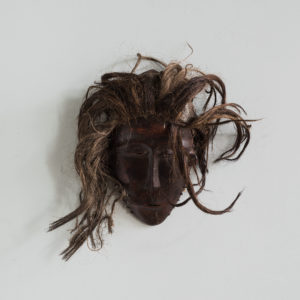
Tchokwe Pwo mask,
£245Tchokwe Pwo mask,
The Pwo is a classic Chokwe mask genre that honours their founding female ancestries as guardians of fertility and procreation. Chokwe masks were made and worn by men, often performed during the celebrations that mark a completion of initiation into adulthood and with means to honour women who had survived the difficulty of childbirth.£245 -
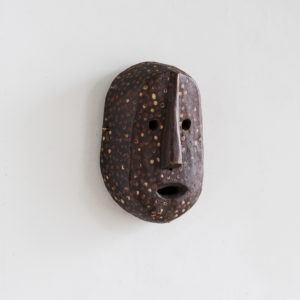
Kusu Nsembu mask
£240Kusu Nsembu mask
The Nsembu mask was used exclusively by members of the Nkunda Secret Society for the purposes of adult initiation and divination; the mask representing the diviners spirit. Painted with natual coloured pigments, its design is reminiscent of certain scarification practices. The Kusu people inhabit the Ituri rainforests, located in the northeastern part of the Congo.£240 -

Songye Luba mask (B)
£200Songye Luba mask (B)
The people of Songye are mainly known as a farming community, however they also take part in hunting and trading with other neighbouring communities. The distinct Songye style is easily recognisable in the Kifwebe mask by the mass of closely carved lines and bold shapes such as the protruding sagittal crest and X carved mouth. The intertwining of the red, black, and white colours in these masks are said to symbolise the struggle between good (white) and evil (black and red) - the combination of these colours embodying the positive and dangerous force held within the mask. Further, it is believed that the sagittal crest and conical protrusion contain the magical strength of the mask.£200 -

Tchokwe Pwo mask,
£195Tchokwe Pwo mask,
The Pwo is a classic Chokwe mask genre that honours their founding female ancestries as guardians of fertility and procreation. Chokwe masks were made and worn by men, often performed during the celebrations that mark a completion of initiation into adulthood and with means to honour women who had survived the difficulty of childbirth. Adorned with typical scarification designs to the face, with braided natural fibres alongside draped blue beads.£195 -

Lega Idimu mask (E)
£180Lega Idimu mask (E)
Similarly to the pipibudze masks of the Kwele tribe, the Lega’s Lukwakongo (miniature) masks have a heart-shaped face framed by a line formed by the nose, the eye rows and the planes of the cheeks. The wooden face is whitened and smoothed with kaolin clay, which is said to allude to the refined and perfected nature of the Bwami initiate, some of whom use the masks during initiation ceremonies. This mask would rarely be worn on the front of the face, but instead on the side of the face, the forehead, tied to the body, displayed on the fences, or dragged across the floor during Bwami meetings and ceremonies. The two faces share a mouth and a beard.£180 -

Kusu Nsembu mask
£180Kusu Nsembu mask
The Nsembu mask was used exclusively by members of the Nkunda Secret Society for the purposes of adult initiation and divination; the mask representing the diviners spirit. Painted with natual coloured pigments, its design is reminiscent of certain scarification practices. The Kusu people inhabit the Ituri rainforests, located in the northeastern part of the Congo.£180 -
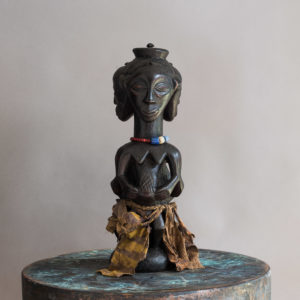
Luba-Hemba triple figural group,
£175Luba-Hemba triple figural group,
Triple maternal power figure with draped cloth fibres and checkered scarification to the belly and head. These wooden power figures would have served to protect the Songye community from evil spirits and practitioners.£175 -

Tchokwe Pwo mask,
£175Tchokwe Pwo mask,
The Pwo is a classic Chokwe mask genre that honours their founding female ancestries as guardians of fertility and procreation. Chokwe masks were made and worn by men, often performed during the celebrations that mark a completion of initiation into adulthood and with means to honour women who had survived the difficulty of childbirth. Minimal scarification design to face and woven natural fibre covering.£175 -

Luba Bilume Kifwebe mask (A)
£175Luba Bilume Kifwebe mask (A)
The people of Songye are mainly known as a farming community, however they also take part in hunting and trading with other neighbouring communities. The distinct Songye style is easily recognisable in the Kifwebe mask by the mass of closely carved lines and bold shapes such as the protruding sagittal crest and X carved mouth. The intertwining of the red, black, and white colouring in these masks are said to symbolise the struggle between good (white) and evil (black and red) - the combination of these colours embodying the positive and dangerous force held within the mask. Further, it is believed that the sagittal crest and conical protrusion contain the magical strength of the mask.£175 -
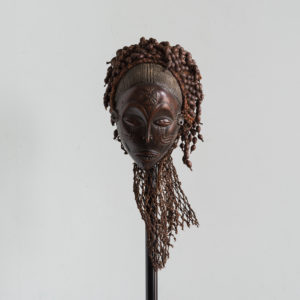
Tchokwe Pwo mask,
£165Tchokwe Pwo mask,
The Pwo is a classic Chokwe mask genre that honours their founding female ancestries as guardians of fertility and procreation. Chokwe masks were made and worn by men, often performed during the celebrations that mark a completion of initiation into adulthood and with means to honour women who had survived the difficulty of childbirth. The occasion is also said to mark the dissolution of intimate bonds between mothers and their sons, which may be represented through the tear carvings and motifs seen on the face. Further, facial scarification as seen on this mask would have been used to make the person less desirable to the spirit of death, and in women specifically would mark the birth of a baby boy.£165 -

Kneeling Luba figure
£150 -

Lega Idimu mask (C)
£140Lega Idimu mask (C)
Similarly to the pipibudze masks of the Kwele tribe, the Lega’s Lukwakongo (miniature) masks have a heart-shaped face framed by a line formed by the nose, the eye rows and the planes of the cheeks. The wooden face is whitened and smoothed with kaolin clay, which is said to allude to the refined and perfected nature of the Bwami initiate, some of whom use the masks during initiation ceremonies. Any holes running around the lower edge of the mask would have held a beard made of natural liana fibres. This mask would rarely be worn on the front of the face, but instead on the side of the face, the forehead, tied to the body, displayed on the fences, or dragged across the floor during Bwami meetings and ceremonies.£140 -

Songye power figure (Nikisi),
£125Songye power figure (Nikisi),
Unusual wooden power figure from the Congolese Songye tribe. Adorned with natural fibres and beaded cowrie necklace. These wooden power figures would have served to protect the Songye community from evil spirits and practitioners.£125 -

Tchokwe Pwo mask,
£125Tchokwe Pwo mask,
The Pwo is a classic Chokwe mask genre that honours their founding female ancestries as guardians of fertility and procreation. Chokwe masks were made and worn by men, often performed during the celebrations that mark a completion of initiation into adulthood and with means to honour women who had survived the difficulty of childbirth. The occasion is also said to mark the dissolution of intimate bonds between mothers and their sons, which may be represented through the tear carvings and motifs seen on the face. Further, facial scarification as seen on this mask would have been used to make the person less desirable to the spirit of death, and in women specifically would mark the birth of a baby boy.£125 -

Baoulé Colon figure in a boat,
£50Baoulé Colon figure in a boat,
African colon figures originated among the Ivory Coast’s Baoulé tribe as an often satirical artistic response to colonisation and European influence. The hand-carved wooden statues commonly depict a Europeanised African middle class, or stereotypical attributes of European design - official uniforms, suits, tobacco pipes, distinct hairstyles and hats. The Baoulé waged one of the longest wars of resistance against French colonisation, and the colon style would achieve international popularity following the second World War. The figure depicts a settler travelling sturdily by canoe boat, the two pieces are not attached. Crossed-sword decorative marking motif may have symbolised a readiness to fight evil.£50 -

Baoulé Colon figure,
£50Baoulé Colon figure,
African colonial figures originated among the Ivory Coast’s Baoulé tribe as an often satirical artistic response to its colonisation and the European influence. The Baoulé waged one of the longest wars of resistance against French colonisation, and the Baoulé colon style would achieve international popularity following the second World War. Their hand-carved wooden statues commonly depict a Europeanised African middle class, or stereotypical attributes of European design such as official uniforms, suits, tobacco pipes, distinct hairstyles and hats. With this figure however, the man stands nude and tall in typical Baoulé posture, half-closed eyes symbolising a peaceful attitude, self-control and patience. The lack of clothing and pigment suggest that this figure did not represent a settler, but a Baoulé person unscathed by or prior to the European influence.£50 -

Baoulé Colon figure,
£50Baoulé Colon figure,
African colon figures originated among the Ivory Coast’s Baoulé tribe as an often satirical artistic response to colonisation and European influence. The hand-carved wooden statues commonly depict a Europeanised African middle class, or stereotypical attributes of European design - official uniforms, suits, tobacco pipes, distinct hairstyles and hats. The Baoulé waged one of the longest wars of resistance against French colonisation, and the colon style would achieve international popularity following the second World War. The figure’s clothing style and pigmentation symbolises a distinct sense of European modernity, whereby fashion and status were key symbols.£50 -

Baoulé Colon figure,
£50Baoulé Colon figure,
African colon figures originated among the Ivory Coast’s Baoulé tribe as an often satirical artistic response to colonisation and European influence. The hand-carved wooden statues commonly depict a Europeanised African middle class, or stereotypical attributes of European design - official uniforms, suits, tobacco pipes, distinct hairstyles and hats. The Baoulé waged one of the longest wars of resistance against French colonisation, and the colon style would achieve international popularity following the second World War. The male figure wears pigment-patterned clothing and clutches a baton above his head. Whether the original statues were intended for ornamental or ritual purpose at the time is debated by anthropologists.£50 -

Baoulé Colon figure,
£50Baoulé Colon figure,
African colon figures originated among the Ivory Coast’s Baoulé tribe as an often satirical artistic response to colonisation and European influence. The hand-carved wooden statues involve at least three craftsmen: the sculptor, the sander, and the painter. They commonly depict a Europeanised African middle class, or stereotypical attributes of European design - official uniforms, suits, tobacco pipes, distinct hairstyles and hats. The Baoulé waged one of the longest wars of resistance against French colonisation, and the colon style would achieve international popularity following the second World War. The male figure stands slumped slightly forward, wearing nothing but a pair of brightly coloured blue shorts and belt. European missionaries would encourage African people to ‘cover up’ in order to instil concepts of puritanism and purdor.£50 -

Baule Colon figure,
£50Baule Colon figure,
African colon figures originated among the Ivory Coast’s Baoulé tribe as an often satirical artistic response to colonisation and European influence. The Baoulé waged one of the longest wars of resistance against French colonisation, and the colon style would achieve international popularity following the second World War. Their hand-carved wooden statues commonly depict a Europeanised African middle class, or stereotypical attributes of European design - official uniforms, suits, tobacco pipes, distinct hairstyles and hats. The female figure wears a Europeanised hairstyle, her breasts hidden by a bikini-style top. European missionaries would encourage African people to ‘cover up’ in order to instil concepts of puritanism and purdor.£50
Featured Items
-

Divagations II, by Henri Matisse, Verve Vol. 1 / No. 1.
£600Divagations II, by Henri Matisse, Verve Vol. 1 / No. 1.
The Verve Review was a purposefully luxurious. It ran from 1937 to 1960, but with only 38 editions available, due to the high degree of design and editorial work dedicated to each issue. Each edition contained unique lithographic prints, commissioned by the editor, and each cover a double-page lithograph elaborated by one of the artists contained within. It was the brainchild of its editor Stratis Eleftheriades, a Greek National who moved to Paris in the early thirties to take part in the growing Modernist movement, writing under the name of Teriade.£600 -

Autumn by Abraham Rattner, Verve Vol. 1 / No. 3.
£600Autumn by Abraham Rattner, Verve Vol. 1 / No. 3.
The Verve Review was a purposefully luxurious. It ran from 1937 to 1960, but with only 38 editions available, due to the high degree of design and editorial work dedicated to each issue. Each edition contained unique lithographic prints, commissioned by the editor, and each cover a double-page lithograph elaborated by one of the artists contained within. It was the brainchild of its editor Stratis Eleftheriades, a Greek National who moved to Paris in the early thirties to take part in the growing Modernist movement, writing under the name of Teriade.£600 -

The Four Elements, Earth by Francisco Bores, Verve Vol. 1 / No. 1.
£600The Four Elements, Earth by Francisco Bores, Verve Vol. 1 / No. 1.
The Verve Review was a purposefully luxurious. It ran from 1937 to 1960, but with only 38 editions available, due to the high degree of design and editorial work dedicated to each issue. Each edition contained unique lithographic prints, commissioned by the editor, and each cover a double-page lithograph elaborated by one of the artists contained within. It was the brainchild of its editor Stratis Eleftheriades, a Greek National who moved to Paris in the early thirties to take part in the growing Modernist movement, writing under the name of Teriade.£600 -

The Four Elements, Fire by Abraham Rattner, Verve Vol. 1 / No. 1.
£600The Four Elements, Fire by Abraham Rattner, Verve Vol. 1 / No. 1.
The Verve Review was a purposefully luxurious. It ran from 1937 to 1960, but with only 38 editions available, due to the high degree of design and editorial work dedicated to each issue. Each edition contained unique lithographic prints, commissioned by the editor, and each cover a double-page lithograph elaborated by one of the artists contained within. It was the brainchild of its editor Stratis Eleftheriades, a Greek National who moved to Paris in the early thirties to take part in the growing Modernist movement, writing under the name of Teriade.£600


